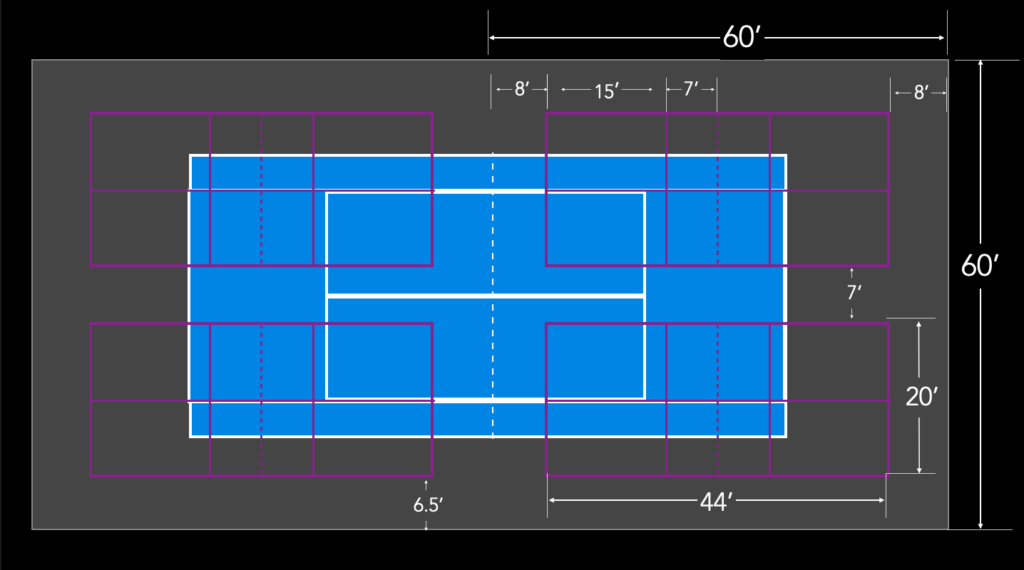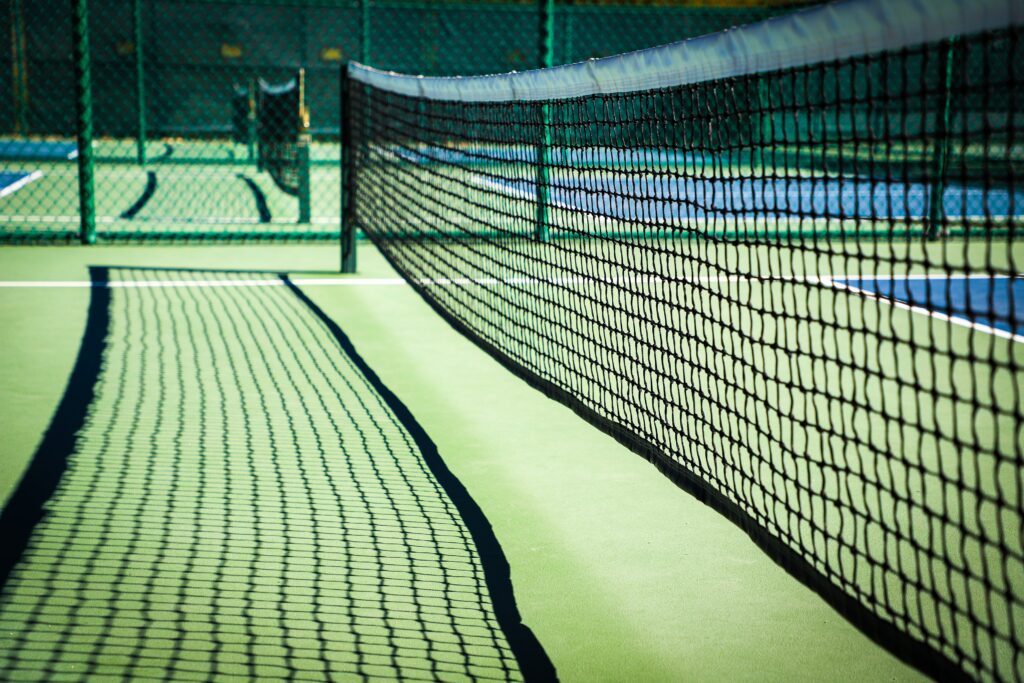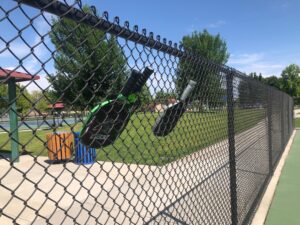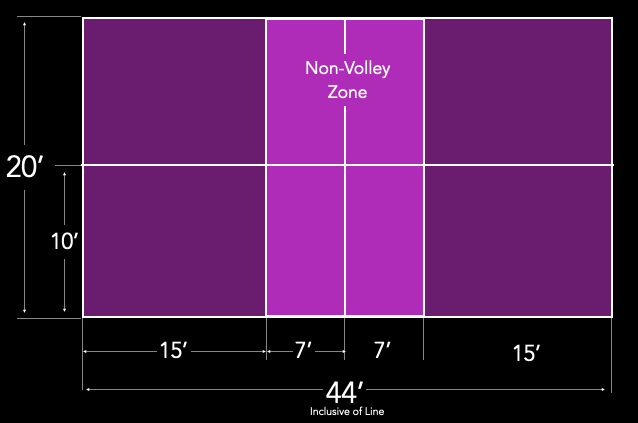Guide to building a pickleball court of your very own
So you’ve got the pickleball bug. Who doesn’t? It’s a great sport for the whole family. But is the nearest pickleball court too far away? Are the courts too crowded when you go to play your afternoon match with friends? Building a pickleball court may be now an enticing and very viable option. If you are lucky enough to have a little bit of land, you can turn plenty of spaces into a pickleball court. This guide will get you started in what you need to do to build a pickleball court of your very own.
Step 1: Find your space that can fit a pickleball court
This will be easy if you already have a flat surface from an old basketball, tennis, badminton, etc. court. Even a flat driveway can be converted for a temporary court. If you don’t already have a flat, hard surface, you will need to level and pave one. The overall playing area you will need to build a pickleball court is 30 feet by 60 feet. This includes the court (court dimensions are 20 feet by 44 feet) plus the out-of-bounds area. Indoor pickleball court dimensions are the same as an outdoor pickleball court, however, you may want to increase the out-of-bounds area to provide more room for players and spectators to maneuver around the playing area.
Build a Pickleball Court from an existing Tennis Court
If you are a municipal or recreation center that has an existing tennis court, then converting one of your tennis courts is a great option. In fact, depending on how much out-of-bounds area you have, you may be able to build four pickleball courts in one of your tennis courts.
Dimensions of a Pickleball Court: Tennis versus Pickleball Court Dimensions

Step 2: Build a pickleball court surface
If you are building your outdoor pickleball court from scratch, you will need to choose what type of court surface is best for you. Asphalt or Concrete both provide an acceptable base for pickleball courts. If you are not experienced in construction, we recommend hiring a professional to install the base as there are specifications for slope and drainage. Choose an experienced contractor with knowledge of tennis court and sports construction to build your pickleball court.
Once the base is in place (asphalt of concrete slab), you can now lay the pickleball court surface. SportMaster Sport Surfaces is the official court surface partner of USA Pickleball. You have a few options when it comes to the court surface layers needed including a cushioned court surface.
Step 3: Install a perimeter fence
Even though pickleballs don’t bounce as high or go as fast as a tennis ball, fencing is still crucial. You need to contain the ball within the playing area and provides security for players. If you are converting from a tennis court, then you likely have more than adequate fencing.
Pickleball court fence dimensions:
The area needs to be at least the size of the pickleball court playing area plus the out-of-bounds (30’x60′). For height, fencing that is 10 feet high is preferred, especially for the back sides. If you are far away from a road or spectators, a fence as low as 4 feet can also work. Another consideration, is the taller the fence, the more sound proofing material you’ll be able to install.
Pickleball court fence types:
The most common fences are chain link, similar to those you see around tennis courts. This is a cost effective option that also allows for spectators to view and for light to pass through. Other options can also easily work especially for the backyard court such as mesh or plastic garden fencing or construction / safety fencing. Just be sure the material you choose is rust-resistant.
Some other considerations on fencing when building a pickleball court:
- The pickleball ball is 65mm. Any openings should be small than that.
- Gates: don’t forget a gate for players to enter and exit! If this is a public court, gates should be on both sides and wide enough to allow for equipment and ADA accommodations.
- Windbreaks: a fence windscreen can help prevent wind from interfering with your play. It can also help with sun glare.
Step 4: Install the pickleball net
You have the option of installing a fixed set-up or a movable net system. If the court is going to be dedicated for pickleball, then installing permanent net posts (or outdoor pickleball poles) will make game setup quick and easy. They also provide greater net tension. Pickleball poles are designed to be directly mounted into a concrete pier and made to be weather resistant.
If you don’t have the ability to install permanent net posts, then a portable net system will be your option. Here are a few top sellers: Zeny, A11N Sports, Pickleball Inc.

Pickleball Court Upgrades: Optional Court Additions
Lighting
Because of the fast-moving nature of pickleball, visibility is essential to gameplay. Consider adding two 1,500 watt light poles. You will want each pole to be around 18 to 20 feet high. A minimum distance of 5 feet from the sideline to light poles is recommended, and padding should be considered if they are inside the fence.
Windscreen
Wind gusts can disturb play and be very frustrating. Adding a windscreen to your perimeter fence can help avoid this interference.
Shade Shelters
Pickleball gameplay can get intense and when the sun is out, heat exhaustion can happen fast. Think about where players and spectators can get a reprieve from the sun.
Spectator seating
Have a big family, lots of neighbors visiting, or is this for a public center? You’ll want some seating for spectators.

Ball Holders, Paddle Rack
Think about where players are going to place their paddles between sets and where you can store extra balls for quick access. There are a variety of equipment storage and organizing solutions out there.
Sound Proofing
Pickleball has a bad rap for being noisy. We explain the reasoning behind this in this article. Whether you agree or not, when you build a pickleball court be a good neighbor and consider installing some noise mitigation . Acoustiblok offers a fencing material that can reduce the noise by 10-12 decibels. The bonus of the Acoustifence is it can also serve as a windscreen.
Building a Pickleball Court Tips and Guidelines
Dimensions of a Pickleball Court
The United States of America Pickleball Association (USAPA) regulation pickleball court dimensions are 20 feet (6.10 m) wide by 44 feet (13.41 m) long. In pickleball, the same sized court is used for singles and doubles play. The rulebook states that the total minimum play area is 30 feet (9.14 m) wide by 60 feet (18.29 m) long when out-of-bounds areas are included. To create your own court quickly, layout markers for the dimensions to include your side lines, base lines, center line, and non-volley zone. There are even kits out there to make this quick and easy.
North-South Orientation
Orienting the court so the length is oriented north-south is optimal for gameplay. This is so one player will not be looking directly into the sun. If the court is oriented in an east-west orientation, morning and afternoon matches could prove hazardous.
Court Lines
Court lines should be white and 2 inches wide. Marker lines can be drawn using sidewalk chalk, contractor’s blue #1 chalk dust, green tape, orange masking tape, or acrylic paint. The court dimensions are inclusive of the line. The standard lines for a pickleball court include:
- Baselines: These run parallel to the pickleball net, 22 feet from the center on both ends of the court.
- Sidelines: These run perpendicular to the pickleball net on both sides of the court. They are 44 feet long, 20 feet apart.
- Non-Volley Line: These lines should be 7 feet from the net and located on each side of the net between sidelines, running parallel to the net.
- Centerlines: Located on each side of the net running between the non-volley line and baseline. The Centerline is 10 feet from the sidelines.
Pickleball Court Dimensions Diagram

Indoor Pickleball Courts
So far we have talked mainly about building an outdoor pickleball court. You can also create your own indoor pickleball court. The lines, netting, and space requirements for indoor pickleball play are the same as outdoor.
Indoor play allows for fluorescent lighting options that cannot function outside. Indoor play also allows for different flooring options that are not feasible outdoors, like hardwood or rubberized surfaces. Fencing considerations can also vary more with indoor courts, as the surrounding environment does not pose as much a risk as it may outdoors.












Pingback: How does Pickleball compare to Tennis? | Pickleball Fever | Momus
Pingback: How to dampen the noise of playing pickleball | Pickleball Fever | Momus
Pingback: How to dampen the noise of pickleball | Pickleball Fever | MOMUS